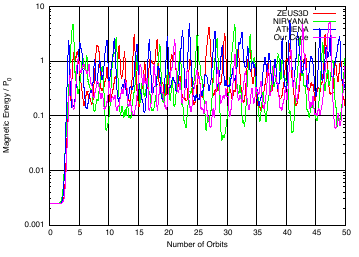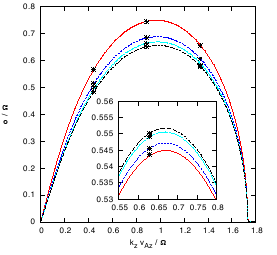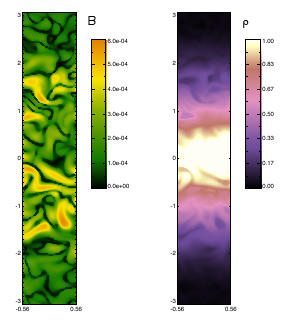INTRODUCTION
In this project we use direct numerical simulations of turbulence to study its effect on planetesimal precursors. The aim is to determine the key parameters for the influence of turbulence on planetesimal formation. We also want to determine the degree to which the precursors can be concentrated locally in protoplanetary discs in particular in flow features such as spiral arms, high pressure regions or vortex structures. The turbulence is induced by the magnetorotational instability (MRI), a linear instability found in rotating, weakly magnetised shear flows (Balbus & Hawley 1991). We model the turbulence in a self-consistent way, where the energy in the turbulent motions is dissipated into heat at small scales and ultimately radiated away by radiative diffusion.NUMERICAL METHOD
 We model the highly conducting magnetized fluid in accretion discs by the equations
of ideal Magnetohydrodynamics (MHD) with radiation transport included in the flux-limited
diffusion approximation. The hydrodynamic part of the equations is solved by a
conservative second order central scheme based on the work by Kurganov et. al. (2001).
The numerical scheme does
not require a Riemann solver, which means it is both very flexible and robust, and thus
idealy suited for turbulence simulations.
The code
runs in parallel using the Message Passing Interface (MPI), which allows to perform
high resolution runs. The simulations take place in a so-called shearing box which
represents a small patch of an accretion disc where local Cartesian coordinates are
used.
Cylindrical and spherical coordinates are also supported, which opens up the
possibility of performing global disc simulations in the future as well.
[The graphic shows the result of a comparison of our code with three other
MHD codes for the case of a standart shearing box setup.]
We model the highly conducting magnetized fluid in accretion discs by the equations
of ideal Magnetohydrodynamics (MHD) with radiation transport included in the flux-limited
diffusion approximation. The hydrodynamic part of the equations is solved by a
conservative second order central scheme based on the work by Kurganov et. al. (2001).
The numerical scheme does
not require a Riemann solver, which means it is both very flexible and robust, and thus
idealy suited for turbulence simulations.
The code
runs in parallel using the Message Passing Interface (MPI), which allows to perform
high resolution runs. The simulations take place in a so-called shearing box which
represents a small patch of an accretion disc where local Cartesian coordinates are
used.
Cylindrical and spherical coordinates are also supported, which opens up the
possibility of performing global disc simulations in the future as well.
[The graphic shows the result of a comparison of our code with three other
MHD codes for the case of a standart shearing box setup.]
GROWTH RATES
 We implemented radiative transport into our code and examined its
influence on the linear stage of the
MRI. By effectively increasing the compressibilty of the fluid, radiative
transport alters the growth rates, but does not change
the region where the instability operates.
This is different from dissipative
processes like viscosity and resistivity, which have the potential to kill
the MRI.
The growth rates may be either reduced or enhanced, depending on the
strength of the toroidal magnetic field and the orientation of the perturbation
wavevector. We have shown that our numerical code accurately reproduces
the analytical prediction for the linear stage of the MRI, thereby justifying
our intent to use it to explore the nonlinear turbulent stage, where no
analytical theory is available.
We have also performed 3D shearing-box simulations in order to examine the impact
of radiative transport on the saturation level of the MRI
(Flaig, Kissmann & Kley 2008). [The graphic shows plots of the MRI growth rate vs.
nondimensional wavenumber for two different situations, where radiation transport
either decreases the growth rates (main graphic) or increases them (inset)].
We implemented radiative transport into our code and examined its
influence on the linear stage of the
MRI. By effectively increasing the compressibilty of the fluid, radiative
transport alters the growth rates, but does not change
the region where the instability operates.
This is different from dissipative
processes like viscosity and resistivity, which have the potential to kill
the MRI.
The growth rates may be either reduced or enhanced, depending on the
strength of the toroidal magnetic field and the orientation of the perturbation
wavevector. We have shown that our numerical code accurately reproduces
the analytical prediction for the linear stage of the MRI, thereby justifying
our intent to use it to explore the nonlinear turbulent stage, where no
analytical theory is available.
We have also performed 3D shearing-box simulations in order to examine the impact
of radiative transport on the saturation level of the MRI
(Flaig, Kissmann & Kley 2008). [The graphic shows plots of the MRI growth rate vs.
nondimensional wavenumber for two different situations, where radiation transport
either decreases the growth rates (main graphic) or increases them (inset)].
OUTLOOK
 We are currently setting up stratified simulations where the vertical component
of gravity is included, leading to a Gaussian density profile with steep
density gradients. Vertically stratified simulations are difficult to perform,
because not only is the density very small in the upper regions, but these are
also stronly magnetised due to the bouyantly rising magnetic fiel, leading to problems
with the boundary conditions and to a small time step due to the huge Alfven speed there.
One aim of this simulations is to determine
the vertical structure in the quasi-steady state where turbulent heating
is balanced by radiative cooling. A major next step will then be to add
dust to the model and examine the dust distribution in the turbulent
flow. After this has been achieved, the simulations might be extended
to the global scale of the disc. [The graphic shows plots of the magnetic
field (left plot) and density (right plot) for a vertically stratified simulation.]
We are currently setting up stratified simulations where the vertical component
of gravity is included, leading to a Gaussian density profile with steep
density gradients. Vertically stratified simulations are difficult to perform,
because not only is the density very small in the upper regions, but these are
also stronly magnetised due to the bouyantly rising magnetic fiel, leading to problems
with the boundary conditions and to a small time step due to the huge Alfven speed there.
One aim of this simulations is to determine
the vertical structure in the quasi-steady state where turbulent heating
is balanced by radiative cooling. A major next step will then be to add
dust to the model and examine the dust distribution in the turbulent
flow. After this has been achieved, the simulations might be extended
to the global scale of the disc. [The graphic shows plots of the magnetic
field (left plot) and density (right plot) for a vertically stratified simulation.]
LITERATURE
Balbus, S. A. & Hawley, J. F. (1991). A powerful local shear instability in weakly magnetized disks. ApJ 376, pages 214-233.Flaig, M., Kissmann, R. & Kley, W. (2008). Growth of the MRI in Accretion Discs - the Influence of Radiation Transport. Submitted to MNRAS.
